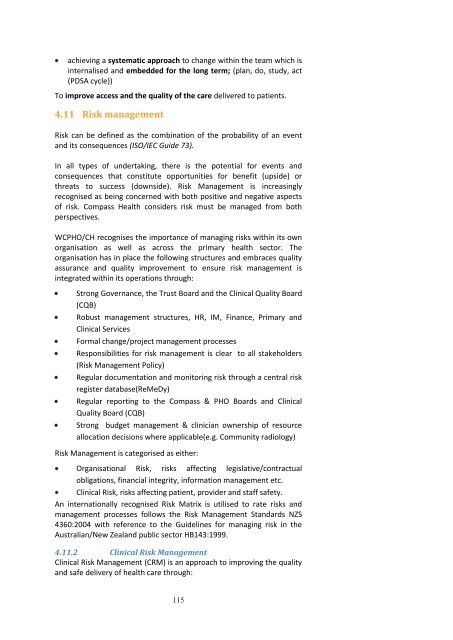Wairarapa Community PHO EOI - New Zealand Doctor
Wairarapa Community PHO EOI - New Zealand Doctor
Wairarapa Community PHO EOI - New Zealand Doctor
You also want an ePaper? Increase the reach of your titles
YUMPU automatically turns print PDFs into web optimized ePapers that Google loves.
achieving a systematic approach to change within the team which is<br />
internalised and embedded for the long term; (plan, do, study, act<br />
(PDSA cycle))<br />
To improve access and the quality of the care delivered to patients.<br />
4.11 Risk management<br />
Risk can be defined as the combination of the probability of an event<br />
and its consequences (ISO/IEC Guide 73).<br />
In all types of undertaking, there is the potential for events and<br />
consequences that constitute opportunities for benefit (upside) or<br />
threats to success (downside). Risk Management is increasingly<br />
recognised as being concerned with both positive and negative aspects<br />
of risk. Compass Health considers risk must be managed from both<br />
perspectives.<br />
WC<strong>PHO</strong>/CH recognises the importance of managing risks within its own<br />
organisation as well as across the primary health sector. The<br />
organisation has in place the following structures and embraces quality<br />
assurance and quality improvement to ensure risk management is<br />
integrated within its operations through:<br />
Strong Governance, the Trust Board and the Clinical Quality Board<br />
(CQB)<br />
Robust management structures, HR, IM, Finance, Primary and<br />
Clinical Services<br />
Formal change/project management processes<br />
Responsibilities for risk management is clear to all stakeholders<br />
(Risk Management Policy)<br />
Regular documentation and monitoring risk through a central risk<br />
register database(ReMeDy)<br />
Regular reporting to the Compass & <strong>PHO</strong> Boards and Clinical<br />
Quality Board (CQB)<br />
Strong budget management & clinician ownership of resource<br />
allocation decisions where applicable(e.g. <strong>Community</strong> radiology)<br />
Risk Management is categorised as either:<br />
Organisational Risk, risks affecting legislative/contractual<br />
obligations, financial integrity, information management etc.<br />
Clinical Risk, risks affecting patient, provider and staff safety.<br />
An internationally recognised Risk Matrix is utilised to rate risks and<br />
management processes follows the Risk Management Standards NZS<br />
4360:2004 with reference to the Guidelines for managing risk in the<br />
Australian/<strong>New</strong> <strong>Zealand</strong> public sector HB143:1999.<br />
4.11.2 Clinical Risk Management<br />
Clinical Risk Management (CRM) is an approach to improving the quality<br />
and safe delivery of health care through:<br />
115

















